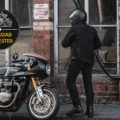Protective motorcycle gear and clothing has and always will be an emotive topic, with many viewpoints. Some riders take the ‘ATGATT’ approach and insist on ‘all the
It’s fair to say that the ‘new wave custom’ scene that’s emerged over the last decade has contributed to and arguably accelerated demand for both protection and style. And now, the requirement pretty much goes hand-in-hand.
A plethora of new and existing brands are feeding that demand. Technology, from other clothing sectors, is now being utilised to produce a wide range of aesthetically pleasing items, that will also save your skin and bones.

Motorcycle Personal Protection Equipment [PPE]
ONUS ON MANUFACTURERS TO OFFER PROTECTION
With the exception of a legally required CE-rated helmet, (certainly, here in the UK and Europe), it’s decidedly, up to the rider to choose what level of protection he or she wants in other motorcycle clothing.
However, let’s say that a rider elects to wear items of clothing that have been labelled as motorcycle
The new regulations place the responsibility on the manufacturer and retailer, rather than the rider, to ensure that the full garment meets the standard it professes.
Over time all motorcycle clothing will need to pass CE certification. As such, as a rider who chooses to wear designated motorcycle clothing, eventually, you will undoubtedly purchase protective clothing whether wittingly or not.

All the
MOTORCYCLE GEAR – PPE CE CERTIFICATION WHAT’S CHANGED?
So how will regulation guarantee that all the
Previously, motorcycle clothing manufacturers had the choice of whether to submit their garments for CE testing or not. Clearly, having CE Certification carries potential retail benefits such as attracting more safety-conscious riders.
However, for manufacturers, the testing is exhaustive and expensive. Now, this isn’t too much of a problem for large established brands but could have substantial financial implications for newer and smaller brands – given the arguably prohibitive costs.
Nevertheless, since 21st April 2018, all items of motorcycle clothing have been classed as Protective Personal Equipment (PPE), by the European Parliament, which makes them subject to ‘Regulation 2016/425’. Under this regulation; any clothing or personal equipment sold to provide protection from injury has to comply with the relevant standard. To ensure complicity, motorcycle

ADDITIONAL COMPLEXITY FOR MANUFACTURERS – MORE ASSURANCE FOR RIDERS
To add further complexity for manufacturers but further reassurance for riders, motorcycle garments must be CE certified as a ‘whole garment’, which means each individual part of the garment must meet the CE criteria in order for the whole garment to be awarded certification.
Let’s use a motorcycle jacket as an example. Every individual component of that jacket has to undergo a multitude of tests, including tear strength (and that’s for all types of material used in construction), abrasion resistance and seam strength. The final rating is then issued, based on the lowest score of all of the components.

Motorcycle Gear Certification, Past
Prior to this regulation coming into effect, many articles of motorcycle

Motorcycle PPE Certification
CE Certification 3 Performance Level Ratings
There are three performance level ratings available, and the only determination of what level is required is down to the rider i.e. you choose the rating based on your type of riding and environment.
Level A – Light-duty protective garments, that provide limited protection to the wearer against injury. However, reduces ergonomic/weight restrictions. Intended where higher levels of protection could be inappropriate. i.e. Warm weather
Level AA – Medium-duty protective garments, that provide medium protection to the wearer against injury. Offers a balance between the level of protection and the ergonomics of its use.
Level AAA – Heavy-duty protective garments, that provide the highest level of protection for the wearer against injury. As such it may not be the lightest or most flexible option.
CHOICE OF GEAR IS LEFT TO UP TO YOU
The good thing is that the regulations still leave the choice to the rider. So thankfully there’s no insistence from a legal point-of-view, to wear full race leathers to nip down to the corner shop on your bobber!
We can only see this as a positive move. Yes, it puts a short-term financial burden on motorcycle clothing manufacturers which could, in theory, could be passed on to the customer. However, once each individual item of the garment has been rated, it can continue to be utilised in and on other garments, with no further testing. So, if a particular leather and style of stitching have already been certified for a jacket, that stitch style can be reused in other garments, with its CE rating still intact.

In some respects, the decision between looking cool and being protected has been taken out of the equation. Yes, you can still continue to choose to ride in non-protective clothing, (t-shirts and shorts) that’s your prerogative. However, if the item you’re purchasing has been designated as motorcycle clothing thus PPE, you’ll know that it’s been stringently tested.
Editor’s Note
A big thank you to RST, for providing some of the information used in this article.






